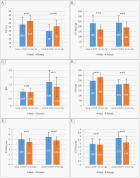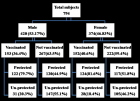Abstract
Editorial
The rising role of natural killer cells in patients with malignant hematological disorders and in recipients of hematopoietic stem cell transplantation
Khalid Ahmed Al-Anazi*
Published: 01 October, 2019 | Volume 3 - Issue 1 | Pages: 023-027
Natural killer (NK) cells, the third population of lymphoid cells, comprise 5%-25% of peripheral blood (PB) lymphocytes and represent the first line of defense against infections and tumors [1-7]. They can be derived from: bone marrow, PB, cryopreserved umbilical cord blood (UCB), human embryonic stem cells (hESCs), induced pluripotent stem cells (iPSCs), and various cell lines such as NK-92 and KHYG-1 [1]. NK cells; which have been divided into cytotoxic, tolerant, and regulatory subsets; are classified into: (1) naïve CD56 bright CD 16 dim CD 3 dim cells, (2) mature CD56 dim CD16 bright CD3 dim cells, and (3) lymphoid tissue-resident CD69+/CXCR6+ NK cells [1,2,8-11]. Although NK cells have been traditionally considered as part of the innate immune system, they have recently been shown to exhibit many of the features associated with adaptive immunity [8,12]. The functions of NK cells which are influenced by several cytokines include: elimination of infected cells, destruction of cancer cells, reducing the incidence of graft versus host disease (GVHD) following hematopoietic stem cell transplantation (HSCT), and regulation of pregnancy outcome [10,11,13].
Read Full Article HTML DOI: 10.29328/journal.jsctt.1001015 Cite this Article Read Full Article PDF
References
- Mehta RS, Randolph B, Daher M, Rezvani K. NK cell therapy for hematologic malignancies. Int J Hematol. 2018; 107: 262-270. PubMed: https://www.ncbi.nlm.nih.gov/pubmed/29383623
- Crinier A, Milpied P, Escalière B, Piperoglou C, Galluso J, et al. High-dimensional single-cell analysis identifies organ-specific signatures and conserved NK cell subsets in humans and mice. Immunity. 2018; 49: 971-986. PubMed: https://www.ncbi.nlm.nih.gov/pubmed/30413361
- Freud AG, Mundy-Bosse BL, Yu J, Caligiuri MA. The broad spectrum of human natural killer cell diversity. Immunity. 2017; 47: 820-833. PubMed: https://www.ncbi.nlm.nih.gov/pubmed/29166586
- Orr MT, Lanier LL. Natural killer cell education and tolerance. Cell. 2010; 142: 847-856. PubMed: https://www.ncbi.nlm.nih.gov/pubmed/20850008
- Abel AM, Yang C, Thakar MS, Malarkannan S. Natural killer cells: development, maturation, and clinical utilization. Front Immunol. 2018; 9: 1869. PubMed: https://www.ncbi.nlm.nih.gov/pubmed/30150991
- van Erp EA, van Kampen MR, van Kasteren PB, de Wit J. Viral infection of human natural killer cells. Viruses. 2019; 11: 243. PubMed: https://www.ncbi.nlm.nih.gov/pmc/articles/PMC6466310/
- Pittari G, Filippini P, Gentilcore G, Grivel JC, Rutella S. Revving up natural killer cells and cytokine-induced killer cells against hematological malignancies. Front Immunol. 2015; 6: 230. PubMed: https://www.ncbi.nlm.nih.gov/pubmed/26029215
- Handgretinger R, Lang P, André MC. Exploitation of natural killer cells for the treatment of acute leukemia. Blood. 2016; 127: 3341-3349. PubMed: https://www.ncbi.nlm.nih.gov/pubmed/27207791
- Robertson MJ. Role of chemokines in the biology of natural killer cells. J Leukoc Biol. 2002; 71: 173-183. PubMed: https://www.ncbi.nlm.nih.gov/pubmed/11818437
- Maghazachi AA. Role of chemokines in the biology of natural killer cells. Curr Top Microbiol Immunol. 2010; 341: 37-58. PubMed: https://www.ncbi.nlm.nih.gov/pubmed/20369317
- Wu Y, Tian Z, Wei H. Developmental and functional control of natural killer cells by cytokines. Front Immunol. 2017; 8: 930. PubMed: https://www.ncbi.nlm.nih.gov/pubmed/28824650
- Tesi B, Schlums H, Cichocki F, Bryceson YT. Epigenetic regulation of adaptive NK cell diversification. Trends Immunol. 2016; 37(7): 451-461. PubMed: https://www.ncbi.nlm.nih.gov/pubmed/27160662
- Chiossone L, Vacca P, Orecchia P, Croxatto D, Damonte P, et al. In vivo generation of decidual natural killer cells from resident hematopoietic progenitors. Haematologica. 2014; 99: 448-57. PubMed: https://www.ncbi.nlm.nih.gov/pubmed/24179150
- Mavers M, Bertaina A. High-risk leukemia: past, present, and future role of NK cells. J Immunol Res. 2018; 2018: 1586905. PubMed: https://www.ncbi.nlm.nih.gov/pubmed/29850617
- Ferlazzo G, Morandi B. Cross-talks between natural killer cells and distinct subsets of dendritic cells. Front Immunol. 2014; 5: 159. PubMed: https://www.ncbi.nlm.nih.gov/pmc/articles/PMC3989561/
- Moretta A. Natural killer cells and dendritic cells: rendezvous in abused tissues. Nat Rev Immunol. 2002; 2: 957-964. PubMed: https://www.ncbi.nlm.nih.gov/pubmed/12461568
- Sanabria MX, Vargas-Inchaustegui DA, Xin L, Soong L. Role of natural killer cells in modulating dendritic cell responses to Leishmania amazonensis infection. Infect Immun. 2008; 76: 5100-5109. PubMed: https://www.ncbi.nlm.nih.gov/pubmed/18794295
- Van Elssen CH, Oth T, Germeraad WT, Bos GM, Vanderlocht J. Natural killer cells: the secret weapon in dendritic cell vaccination strategies. Clin Cancer Res. 2014; 20:1095-1103. PubMed: https://www.ncbi.nlm.nih.gov/pubmed/24590885
- Harizi H. Reciprocal crosstalk between dendritic cells and natural killer cells under the effects of PGE2 in immunity and immunopathology. Cell Mol Immunol. 2013; 10: 213-221. PubMed: https://www.ncbi.nlm.nih.gov/pubmed/23524652
- Calmeiro J, Carrascal M, Gomes C, Falcão A, Cruz MT, et al. Heighlighting the role of DC-NK cell interplay in immunobiology and immunotherapy. In: Dendritic cells. Edited by: Chapoval SP. Intech Open 2018.
- Gerosa F, Baldani-Guerra B, Nisii C, Marchesini V, Carra G, et al. Reciprocal activating interaction between natural killer cells and dendritic cells. J Exp Med. 2002; 195: 327-333. PubMed: https://www.ncbi.nlm.nih.gov/pubmed/11828007
- Piccioli D, Sbrana S, Melandri E, Valiante NM. Contact-dependent stimulation and inhibition of dendritic cells by natural killer cells. J Exp Med. 2002; 195(3): 335-341. PubMed: https://www.ncbi.nlm.nih.gov/pubmed/11828008
- Galland S, Vuille J, Martin P, Letovanec I, Caignard A, et al. Tumor-derived mesenchymal stem cells use distinct mechanisms to block the activity of natural killer cell subsets. Cell Rep. 2017; 20: 2891-2905. PubMed: https://www.ncbi.nlm.nih.gov/pubmed/28930684
- Najar M, Fayyad-Kazan M, Merimi M, Burny A, Bron D, et al. Mesenchymal stromal cells and natural killer cells: a complex story of love and hate. Curr Stem Cell Res Ther. 2019; 14: 14-21. PubMed: https://www.ncbi.nlm.nih.gov/pubmed/30207245
- Najar M, Fayyad-Kazan M, Meuleman N, Bron D, Fayyad-Kazan H, et al. Mesenchymal stromal cells of the bone marrow and natural killer cells: cell interactions and cross modulation. J Cell Commun Signal. 2018; 12: 673-688. PubMed: https://www.ncbi.nlm.nih.gov/pubmed/29350342
- Thomas H, Jäger M, Mauel K, Brandau S, Lask S, et al. Interaction with mesenchymal stem cells provokes natural killer cells for enhanced IL-12/IL-18-induced interferon-gamma secretion. Mediators Inflamm. 2014; 2014: 143463. PubMed: https://www.ncbi.nlm.nih.gov/pubmed/24876666
- Sotiropoulou PA, Perez SA, Gritzapis AD, Baxevanis CN, Papamichail M. Interactions between human mesenchymal stem cells and natural killer cells. Stem Cells. 2006; 24: 74-85. PubMed: https://www.ncbi.nlm.nih.gov/pubmed/16099998
- Merker M, Salzmann-Manrique E, Katzki V, Huenecke S, Bremm M, et al. Clearance of hematologic malignancies by allogeneic cytokine-induced killer cell or donor lymphocyte infusions. Biol Blood Marrow Transplant. 2019; 25: 1281-1292. PubMed: https://www.ncbi.nlm.nih.gov/pubmed/30878607
- Chan YLT, Zuo J, Inman C, Croft W, Begum J, et al. NK cells produce high levels of IL-10 early after allogeneic stem cell transplantation and suppress development of acute GVHD. Eur J Immunol. 2018; 48: 316-329. PubMed: https://www.ncbi.nlm.nih.gov/pubmed/28944953
- Carlsten M, Korde N, Kotecha R, Reger R, Bor S, et al. Checkpoint inhibition of KIR2D with the monoclonal antibody IPH2101 induces contraction and hyporesponsiveness of NK Cells in patients with myeloma. Clin Cancer Res. 2016; 22: 5211-5222. PubMed: https://www.ncbi.nlm.nih.gov/pubmed/27307594
- Gabriel IH, Sergeant R, Szydlo R, Apperley JF, DeLavallade H, et al. Interaction between KIR3DS1 and HLA-Bw4 predicts for progression-free survival after autologous stem cell transplantation in patients with multiple myeloma. Blood. 2010; 116: 2033-2039. PubMed: https://www.ncbi.nlm.nih.gov/pubmed/20562327
- Benson DM Jr, Hofmeister CC, Padmanabhan S, Suvannasankha A, Jagannath S, et al. A phase 1 trial of the anti-KIR antibody IPH2101 in patients with relapsed/refractory multiple myeloma. Blood 2012; 120: 4324-4333. PubMed: https://www.ncbi.nlm.nih.gov/pubmed/23033266
- Hoteit R, Bazarbachi A, Antar A, Salem Z, Shammaa D, et al. KIR genotype distribution among patients with multiple myeloma: Higher prevalence of KIR 2DS4 and KIR 2DS5 genes. Meta Gene 2014; 2: 730-736. PubMed: https://www.ncbi.nlm.nih.gov/pubmed/25606456
- Petri RM, Hackel A, Hahnel K, Dumitru CA, Bruderek K, et al. Activated tissue-resident mesenchymal stromal cells regulate natural killer cell immune and tissue-regenerative function. Stem Cell Rep. 2017; 9: 985-998. PubMed: https://www.ncbi.nlm.nih.gov/pubmed/28781075
- Pittari G, Vago L, Festuccia M, Bonini C, Mudawi D, et al. Restoring natural killer cell immunity against multiple myeloma in the era of new drugs. Front Immunol. 2017; 8: 1444. PubMed: https://www.ncbi.nlm.nih.gov/pmc/articles/PMC5682004/
- Shah N, Li L, McCarty J, Kaur I, Yvon E, et al. Phase I study of cord blood-derived natural killer cells combined with autologous stem cell transplantation in multiple myeloma. Br J Haematol. 2017; 177: 457-466. PubMed: https://www.ncbi.nlm.nih.gov/pubmed/28295190
- Kröger N, Shaw B, Iacobelli S, Zabelina T, Peggs K, et al; Clinical Trial Committee of the British Society of Blood and Marrow Transplantation and the German Cooperative Transplant Group. Comparison between antithymocyte globulin and alemtuzumab and the possible impact of KIR-ligand mismatch after dose-reduced conditioning and unrelated stem cell transplantation in patients with multiple myeloma. Br J Haematol. 2005; 129: 631-643. PubMed: https://www.ncbi.nlm.nih.gov/pubmed/15916686
- Shi J, Tricot G, Szmania S, Rosen N, Garg TK, et al. Infusion of haplo-identical killer immunoglobulin-like receptor ligand mismatched NK cells for relapsed myeloma in the setting of autologous stem cell transplantation. Br J Haematol. 2008; 143: 641-653. PubMed: https://www.ncbi.nlm.nih.gov/pubmed/18950462
- Simonetta F, Alvarez M, Negrin RS. Natural killer cells in graft-versus-host-disease after allogeneic hematopoietic cell transplantation. Front Immunol. 2017; 8:465. PubMed: https://www.ncbi.nlm.nih.gov/pubmed/28487696
- Cruz CR, Bollard CM. T-cell and natural killer cell therapies for hematologic malignancies after hematopoietic stem cell transplantation: enhancing the graft-versus-leukemia effect. Haematologica. 2015; 100(6): 709-719. PubMed: https://www.ncbi.nlm.nih.gov/pubmed/26034113
- Yang XY, Zeng H, Chen FP. Cytokine-induced killer cells: a novel immunotherapy strategy for leukemia. Oncol Lett. 2015; 9: 535-541. PubMed: https://www.ncbi.nlm.nih.gov/pmc/articles/PMC4301482/
- Mavers M, Bertaina A. High-risk leukemia: past, present, and future role of NK cells. J Immunol Res. 2018; 2018: 1586905. PubMed: https://www.ncbi.nlm.nih.gov/pubmed/29850617
- Hattori N, Nakamaki T. Natural killer immunotherapy for minimal residual disease eradication following allogeneic hematopoietic stem cell transplantation in acute myeloid leukemia. Int J Mol Sci. 2019; 20: E2057. PubMed: https://www.ncbi.nlm.nih.gov/pubmed/31027331
- Chouaib S, Pittari G, Nanbakhsh A, El Ayoubi H, Amsellem S, et al. Improving the outcome of leukemia by natural killer cell-based immunotherapeutic strategies. Front Immunol. 2014; 5: 95. PubMed: https://www.ncbi.nlm.nih.gov/pmc/articles/PMC3956082/
- Shah NN, Baird K, Delbrook CP, Fleisher TA, Kohler ME, et al. Acute GVHD in patients receiving IL-15/4-1BBL activated NK cells following T-cell-depleted stem cell transplantation. Blood 2015; 125: 784-792. PubMed: https://www.ncbi.nlm.nih.gov/pubmed/25452614
- Chen YB, Efebera YA, Johnston L, Ball ED, Avigan D, et al. Increased Foxp3+Helios+ regulatory T cells and decreased acute graft-versus-host disease after allogeneic bone marrow transplantation in patients receiving sirolimus and RGI-2001, an activator of invariant natural killer T cells. Biol Blood Marrow Transplant. 2017; 23: 625-634. PubMed: https://www.ncbi.nlm.nih.gov/pubmed/28104514
- Lupo KB, Matosevic S. Natural killer cells as allogeneic effectors in adoptive cancer immunotherapy. Cancers (Basel). 2019; 11: E769. PubMed: https://www.ncbi.nlm.nih.gov/pubmed/31163679
- Du J, Paz K, Thangavelu G, Schneidawind D, Baker J, et al. Invariant natural killer T cells ameliorate murine chronic GVHD by expanding donor regulatory T cells. Blood. 2017; 129: 3121-3125. PubMed: https://www.ncbi.nlm.nih.gov/pubmed/28416503
- Sun W, Wang Y, East JE, Kimball AS, Tkaczuk K, et al. Invariant natural killer T cells generated from human adult hematopoietic stem-progenitor cells are poly-functional. Cytokine. 2015; 72: 48-57. PubMed: https://www.ncbi.nlm.nih.gov/pubmed/25569376
- Rettinger E, Huenecke S, Bonig H, Merker M, Jarisch A, et al. Interleukin-15-activated cytokine-induced killer cells may sustain remission in leukemia patients after allogeneic stem cell transplantation: feasibility, safety and first insights on efficacy. Haematologica. 2016; 101: e153-6. PubMed: https://www.ncbi.nlm.nih.gov/pmc/articles/PMC5004389/
- Russo A, Oliveira G, Berglund S, Greco R, Gambacorta V, et al. NK cell recovery after haploidentical HSCT with posttransplant cyclophosphamide: dynamics and clinical implications. Blood. 2018; 131(2): 247-262. PubMed: https://www.ncbi.nlm.nih.gov/pubmed/28986344
- Gill S, Olson JA, Negrin RS. Natural killer cells in allogeneic transplantation: effect on engraftment, graft- versus-tumor, and graft-versus-host responses. Biol Blood Marrow Transplant. 2009; 15: 765-776. PubMed: https://www.ncbi.nlm.nih.gov/pubmed/19539207
- Herrera L, Salcedo JM, Santos S, Vesga MÁ, Borrego F, et al. OP9 feeder cells are superior to M2-10B4 cells for the generation of mature and functional natural killer cells from umbilical cord hematopoietic progenitors. Front Immunol. 2017; 8: 755. PubMed: https://www.ncbi.nlm.nih.gov/pubmed/28713379
- Bassani B, Baci D, Gallazzi M, Poggi A, Bruno A, et al. Natural killer cells as key players of tumor progression and angiogenesis: old and novel tools to divert their pro-tumor activities into otent anti-tumor effects. Cancers (Basel) 2019; 11(4). pii: E461. PubMed: https://www.ncbi.nlm.nih.gov/pubmed/30939820
- Veluchamy JP, Kok N, van der Vliet HJ, Verheul HMW, de Gruijl TD, et al. The rise of allogeneic natural killer cells as a platform for cancer immunotherapy: recent innovations and future developments. Front Immunol. 2017; 8: 631. PubMed: https://www.ncbi.nlm.nih.gov/pubmed/28620386
- Hu W, Wang G, Huang D, Sui M, Xu Y. Cancer immunotherapy based on natural killer cells: current progress and new opportunities. Front Immunol. 2019; 10: 1205. PubMed: https://www.ncbi.nlm.nih.gov/pmc/articles/PMC6554437/
- Liu LL, Béziat V, Oei VYS, Pfefferle A, Schaffer M, et al. Ex vivo expanded adaptive NK cells effectively kill primary acute lymphoblastic leukemia cells. Cancer Immunol Res. 2017; 5: 654-665. PubMed: https://www.ncbi.nlm.nih.gov/pubmed/28637877
- MacFarlane AW, Jillab M, Smith MR, Katherine Alpaugh R, Cole ME, et al. Natural killer cell dysfunction in chronic lymphocytic leukemia is associated with loss of the mature KIR3DL1+ subset. Blood. 2014; 124: 3318.
- Chen CI, Koschmieder S, Kerstiens L, Schemionek M, Altvater B, et al. NK cells are dysfunctional in human chronic myelogenous leukemia before and on imatinib treatment and in BCR-ABL-positive mice. Leukemia. 2012; 26(3): 465-474. PubMed: https://www.ncbi.nlm.nih.gov/pubmed/21904381
- Chiu J, Ernst DM, Keating A. Acquired natural killer cell dysfunction in the tumor microenvironment of classic Hodgkin lymphoma. Front Immunol. 2018; 9: 267. PubMed: https://www.ncbi.nlm.nih.gov/pubmed/29491867
- Kohrt HE, Thielens A, Marabelle A, Sagiv-Barfi I, Sola C, et al. Anti-KIR antibody enhancement of anti-lymphoma activity of natural killer cells as monotherapy and in combination with anti-CD20 antibodies. Blood. 2014; 123(5): 678-686. PubMed: https://www.ncbi.nlm.nih.gov/pubmed/24326534a
Similar Articles
-
The Femoral Head of Patients with Hip Dysplasia is not as Osteogenic as Iliac Crest Bone LocationPhilippe Hernigou*,Yasuhiro Homma,Arnaud Dubory,Jacques Pariat,Damien Potage,Charles Henri Flouzat Lachaniette,Nathalie Chevallier,Helene Rouard . The Femoral Head of Patients with Hip Dysplasia is not as Osteogenic as Iliac Crest Bone Location. . 2017 doi: 10.29328/journal.jsctt.1001001; 1: 001-007
-
Rhabdomyoblasts in Pediatric Tumors: A Review with Emphasis on their Diagnostic UtilityGiuseppe Angelico*,Eliana Piombino,Giuseppe Broggi,Fabio Motta,Saveria Spadola. Rhabdomyoblasts in Pediatric Tumors: A Review with Emphasis on their Diagnostic Utility . . 2017 doi: 10.29328/journal.jsctt.1001002; 1: 008-016
-
Surgical Implantation of Stem Cells in Heart Failure Patients due to Idiophatic CardiomyopathyBenetti Federico*,Natalia Scialacomo,Enrique Mariani,Luis Geffner,Bruno Benetti Eng1,Daniel Brusich,Yan Duarte. Surgical Implantation of Stem Cells in Heart Failure Patients due to Idiophatic Cardiomyopathy. . 2017 doi: 10.29328/journal.jsctt.1001003; 1: 017-027
-
Enhancing adipose stem cell chondrogenesis: A study on the roles of dexamethasone, transforming growth factor β3 and ascorbate supplements and their combinationBernard J Van Wie*,Arshan Nazempour##,Chrystal R Quisenberry##,Nehal I Abu-Lail. Enhancing adipose stem cell chondrogenesis: A study on the roles of dexamethasone, transforming growth factor β3 and ascorbate supplements and their combination. . 2017 doi: 10.29328/journal.jsctt.1001004; 1: 028-051
-
Arid3a regulates mesoderm differentiation in mouse embryonic stem cellsHaley O Tucker*,Melissa Popowski,Bum-kyu Lee,Vishwanath R Iyer,Cathy Rhee. Arid3a regulates mesoderm differentiation in mouse embryonic stem cells. . 2017 doi: 10.29328/journal.jsctt.1001005; 1: 052-062
-
Nicotinamide as a treatment option of Age-Related Macular DegenerationChristine Skerka*,Yuchen Lin,Peter F. Zipfel. Nicotinamide as a treatment option of Age-Related Macular Degeneration. . 2017 doi: 10.29328/journal.jsctt.1001006; 1: 063-065
-
Intraepidermal Injections of Autologous Epidermal Cell Suspension: A new promising approach to Dermatological Disorders. Preliminary StudyFabio Rinaldi*,Elisa Borsani,Luigi Fabrizio Rodella,Elisabetta Sorbellini,Rita Rezzani,Daniela Pinto,Barbara Marzani,Giovanna Tabellini,Mariangela Rucco. Intraepidermal Injections of Autologous Epidermal Cell Suspension: A new promising approach to Dermatological Disorders. Preliminary Study. . 2017 doi: 10.29328/journal.jsctt.1001007; 1: 066-070
-
Stemness of Mesenchymal Stem CellsTong Ming Liu*. Stemness of Mesenchymal Stem Cells. . 2017 doi: 10.29328/journal.jsctt.1001008; 1: 071-073
-
Stem cells in heart failure some considerationsFederico Benetti*,Natalia Scialacomo,Bruno Benetti. Stem cells in heart failure some considerations. . 2018 doi: 10.29328/journal.jsctt.1001009; 2: 001-003
-
Stem cells in patients with heart failure experienceBenetti Federico*,Natalia Scialacomo. Stem cells in patients with heart failure experience. . 2018 doi: 10.29328/journal.jsctt.1001010; 2: 004-014
Recently Viewed
-
Atypical Anti-GBM with ANCA Vasculitis- A Rarest of the Rare Entity: Index Case from Eastern IndiaGopambuj Singh Rathod*, Atanu Pal, Pallavi Mahato, Aakash Roy, Debroop Sengupta, Muzzamil Ahmad. Atypical Anti-GBM with ANCA Vasculitis- A Rarest of the Rare Entity: Index Case from Eastern India. J Clini Nephrol. 2024: doi: 10.29328/journal.jcn.1001139; 8: 124-126
-
Gallstone Ileus: A Rare Case of Intestinal Obstruction, Presented in a Chronic Kidney Disease Patient on HaemodialysisPulak Azad*,Yasir Sultan Rizvi,Lakshmi Kant Jha,Pranav Tyagi,Sachin Jain,Twinkle Malik. Gallstone Ileus: A Rare Case of Intestinal Obstruction, Presented in a Chronic Kidney Disease Patient on Haemodialysis. J Clini Nephrol. 2025: doi: 10.29328/journal.jcn.1001149; 9: 027-030
-
A Case of Rapidly Progressive Renal Failure with Unearthed AmyloidosisPulak Azad*,Lakshmi Kant Jha,Yasir Sultan Rizvi,Pranav Tyagi. A Case of Rapidly Progressive Renal Failure with Unearthed Amyloidosis. J Clini Nephrol. 2025: doi: 10.29328/journal.jcn.1001140; 9: 024-026
-
An Adult Case of Beta Thalassemia with Right Ventricular Outflow Tract Tachycardia: A Case ReportPrem AS,Shahanas PS,Praveen Sreekumar*,Ramaswamy NV. An Adult Case of Beta Thalassemia with Right Ventricular Outflow Tract Tachycardia: A Case Report. J Cardiol Cardiovasc Med. 2024: doi: 10.29328/journal.jccm.1001201; 9: 177-179
-
Autoantibodies in Autoimmune Addison’s Disease: Why are they Important?Maria Rosaria De Cagna, Norma Notaristefano, Maurizio Schiavone, Gianluca Palatella, Federica Ranù, Carmela Presicci, Valerio Cecinati, Marilina Tampoia*. Autoantibodies in Autoimmune Addison’s Disease: Why are they Important?. Arch Pathol Clin Res. 2024: doi: 10.29328/journal.apcr.1001042; 8: 012-015
Most Viewed
-
Evaluation of Biostimulants Based on Recovered Protein Hydrolysates from Animal By-products as Plant Growth EnhancersH Pérez-Aguilar*, M Lacruz-Asaro, F Arán-Ais. Evaluation of Biostimulants Based on Recovered Protein Hydrolysates from Animal By-products as Plant Growth Enhancers. J Plant Sci Phytopathol. 2023 doi: 10.29328/journal.jpsp.1001104; 7: 042-047
-
Sinonasal Myxoma Extending into the Orbit in a 4-Year Old: A Case PresentationJulian A Purrinos*, Ramzi Younis. Sinonasal Myxoma Extending into the Orbit in a 4-Year Old: A Case Presentation. Arch Case Rep. 2024 doi: 10.29328/journal.acr.1001099; 8: 075-077
-
Feasibility study of magnetic sensing for detecting single-neuron action potentialsDenis Tonini,Kai Wu,Renata Saha,Jian-Ping Wang*. Feasibility study of magnetic sensing for detecting single-neuron action potentials. Ann Biomed Sci Eng. 2022 doi: 10.29328/journal.abse.1001018; 6: 019-029
-
Pediatric Dysgerminoma: Unveiling a Rare Ovarian TumorFaten Limaiem*, Khalil Saffar, Ahmed Halouani. Pediatric Dysgerminoma: Unveiling a Rare Ovarian Tumor. Arch Case Rep. 2024 doi: 10.29328/journal.acr.1001087; 8: 010-013
-
Physical activity can change the physiological and psychological circumstances during COVID-19 pandemic: A narrative reviewKhashayar Maroufi*. Physical activity can change the physiological and psychological circumstances during COVID-19 pandemic: A narrative review. J Sports Med Ther. 2021 doi: 10.29328/journal.jsmt.1001051; 6: 001-007

HSPI: We're glad you're here. Please click "create a new Query" if you are a new visitor to our website and need further information from us.
If you are already a member of our network and need to keep track of any developments regarding a question you have already submitted, click "take me to my Query."

























































































































































